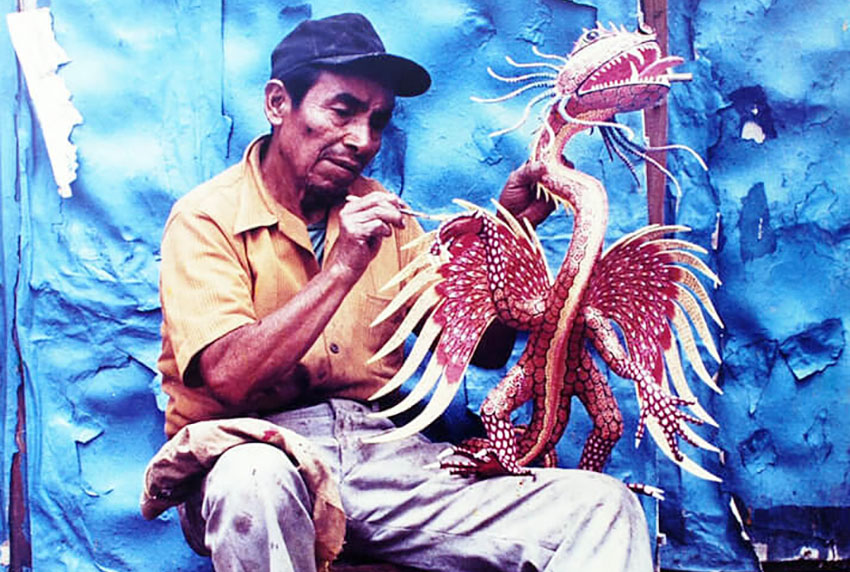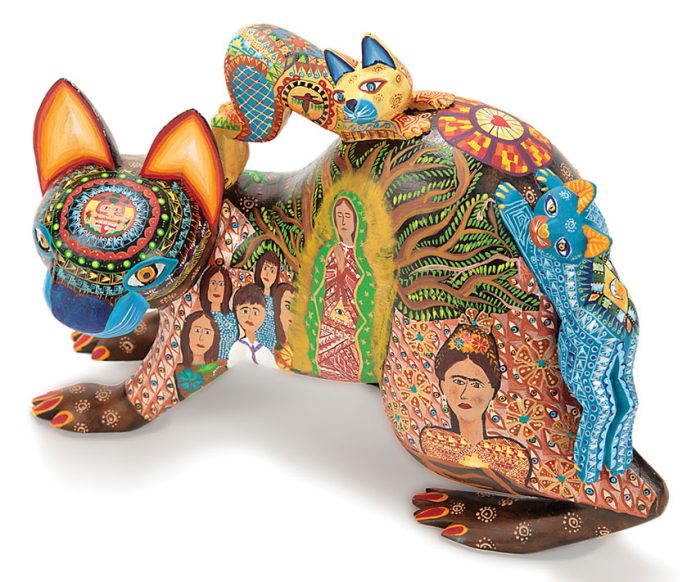In the 2017 movie Coco, Walt Disney Pictures popularized the idea of alebrije for mass audiences around the globe as a kind of “spirit-guide” between the lands of the living and the dead.
This is not what alebrijes are in Mexico, but a cultural and legal dispute is centered on their definition.
There are essentially two craft figures made in Mexico that claim the title – wood carvings from the state of Oaxaca, and papier-mache figures from Mexico City.
Both versions appear in the movie. At the beginning, the boy is seen painting animal figures in bright colors and meticulous patterns. This is a nod to the Oaxaca tradition. The “spirit guide,” however, is an amalgam of animal parts, recognizing the creatures credited to master craftsman Pedro Linares.
So which is the real alebrije?

Let’s start with what is not in dispute. Pedro Linares was an artisan who worked making holiday and festival decorations in papier-mache. Sometime in the late 1930s or 1940s, he began making colorful creatures which combined body parts from several animals, real or imagined. These were painted in bright, often clashing colors and became popular as collectors’ items in Mexico City.
According to family lore, maestro Pedro fell ill with a high fever and while unconscious, dreamed about various monsters which he described as both beautiful and scary at the same time. The creatures whispered “alebrije,” resulting in the name. After recovering, Linares used his papier-mache skills to recreate what he saw.
It’s a great story but not literally true. There is no firm date, not even a year, for when Linares had such a dream or when he began making the monsters. Instead, there is photographic evidence that shows that the creatures evolved from modifications of “judases,” a devil-like effigy burned on Holy Saturday.
How Linares created alebrijes does not really matter. What does matter is that these creatures speak to the Mexican psyche. Otherwise, the making of alebrijes would have died with the maestro.
In Mexico, intellectual property rights must be claimed, and Pedro Linares did not do the required paperwork. It is rare for a Mexican artisan even to sign his or her work, never mind think that it needs legal protection.
After the maestro’s death in 1992, the Mexican federal government passed laws that declared folk art/handcrafts to be the national heritage of Mexico, severely limiting any individual rights artisans may have. Since alebrijes were never patented or trademarked, most authorities consider them to be folk art.

So how did “alebrijes” wind up in Oaxaca? Although there have been attempts to claim him as oaxaqueño, Pedro Linares had absolutely no connection with the state.
The colorful wood carvings with the same name are the brainchild of Manuel Jiménez of San Antonio Arrazola, just outside the city of Oaxaca. Like their Mexico City cousins, they are in bright colors. However, the painting is much finer and more detailed. The creatures themselves principally depict only one animal.
Should the carvings be called alebrijes?
According to the Linares family and supporters, the answer is no. They state that the work of Pedro Linares, as defined by his heirs, should be the determining factor. The Oaxacan creatures should be called tonas.
The Linares family has worked hard to promote this idea. Grandson Leonardo Linares did what Pedro did not, make an official claim to the creation and the name. This documentation has had some legal and moral effect, but it is far from the last word on the subject. In addition to alebrijes’ folk art status, there is a question as to whether the family has any legal standing to rights Pedro never claimed.
On the other hand, Jiménez’s work does have some link to Pedro Linares. The two artisans met in the 1970s through documentary filmmaker Judith Bronowski. Jiménez adapted Linares’ idea to the medium he was proficient in – Oaxacan-style wood carving.

Jiménez’s version is far more commercially successful because it has wider appeal and Oaxaca is a major tourist destination. The carvings have been called alebrijes since their inception, and Oaxacan woodworkers have shown no interest in changing the name to appease artisans from Mexico City.
Even among Mexico’s papier-mache artisans, the Linares claim has not had an enthusiastic reception. Artisans are certainly aware of how vulnerable their work is to imitation, not only from other artisans but also from international manufacturers. But papier-mache artisans are dependent on the folk-art designation of alebrijes and the freedom it gives them to make the figures and use the term.
Disney is evidently aware of the matter, to its credit. But this thorny issue shows that the adaptation of cultural and artistic imagery can cause problems within a country as well as globally.
Leigh Thelmadatter’s culture blog appears weekly at Mexico News Daily.
